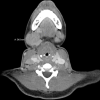Adult-Onset Still's Disease With Extensive Lymphadenopathy Mimicking Lymphoproliferative Malignancy
- PMID: 34367773
- PMCID: PMC8336297
- DOI: 10.7759/cureus.16163
Adult-Onset Still's Disease With Extensive Lymphadenopathy Mimicking Lymphoproliferative Malignancy
Abstract
Adult-onset Still's disease (AOSD), a rare systemic inflammatory disorder of unknown etiology, is considered in broad differential in patients with fever of unknown origin or unexplained lymphadenopathy. It is characterized by spiking fever, evanescent salmon-colored maculopapular rash, arthritis or arthralgia, and leukocytosis. Due to broad differentials and lack of any specific diagnostic tests, diagnosis of AOSD poses a great challenge. A concerned physician should have a high index of suspicion while dealing with patients presenting with clinical symptoms of this systemic disorder. We report a case of a 25-year-old African American female with the past medical history of AOSD, who presented with four weeks history of extensive cervical and axillary lymphadenopathy mimicking lymphoproliferative malignancy. Cases have been reported with the development of malignant lymphoma during the course of AOSD. Therefore, careful monitoring of patients with regular follow-up is vital as these patients may develop lymphoproliferative malignancy in the future.
Keywords: adult-onset still’s disease; lymphadenopathy; lymphoma; lymphoproliferative malignancy; polyarthritis.
Copyright © 2021, Paul et al.
Conflict of interest statement
The authors have declared that no competing interests exist.
Figures




Similar articles
-
A Case of Adult-Onset Still's Disease Presenting with Urticated Plaques and Acute Myopericarditis.Indian J Dermatol. 2013 Sep;58(5):405. doi: 10.4103/0019-5154.117316. Indian J Dermatol. 2013. PMID: 24082197 Free PMC article.
-
Adult-onset Still's disease with disseminated intravascular coagulation and hemophagocytic syndrome: a case report.BMC Res Notes. 2014 Dec 22;7:940. doi: 10.1186/1756-0500-7-940. BMC Res Notes. 2014. PMID: 25532568 Free PMC article.
-
Urticarial rash, fever, and arthritis: A case of refractory Adult-onset Still's disease with good response to tocilizumab.Dermatol Ther. 2019 Sep;32(5):e13041. doi: 10.1111/dth.13041. Epub 2019 Aug 12. Dermatol Ther. 2019. PMID: 31361930 Review.
-
Adult-Onset Still's Disease With Severe Hyperferritinemia and the Asian Salmon-Pink Rash: A Case Report.Cureus. 2022 Jun 23;14(6):e26257. doi: 10.7759/cureus.26257. eCollection 2022 Jun. Cureus. 2022. PMID: 35911342 Free PMC article.
-
A comprehensive review on adult onset Still's disease.J Autoimmun. 2018 Sep;93:24-36. doi: 10.1016/j.jaut.2018.07.018. Epub 2018 Aug 1. J Autoimmun. 2018. PMID: 30077425 Review.
Cited by
-
The community of the DAO.Nat Biotechnol. 2023 Oct;41(10):1357. doi: 10.1038/s41587-023-02005-1. Nat Biotechnol. 2023. PMID: 37783849 No abstract available.
References
-
- Adult-onset Still disease. Fautrel B. Best Pract Res Clin Rheumatol. 2008;22:773–792. - PubMed
-
- Adult Still's disease: manifestations, disease course, and outcome in 62 patients. Pouchot J, Sampalis JS, Beaudet F, et al. https://europepmc.org/article/med/2005777. Medicine. 1991;70:118–136. - PubMed
-
- Adult Still's disease as a paraneoplastic manifestation of breast cancer. Neishi J, Tsukada Y, Maehara T, Ueki K, Maezawa A, Nojima Y. Scand J Rheumatol. 2000;29:328–330. - PubMed
Publication types
LinkOut - more resources
Full Text Sources
Miscellaneous
